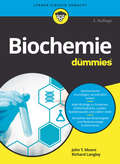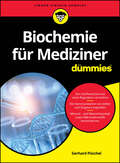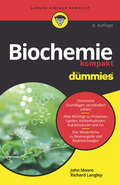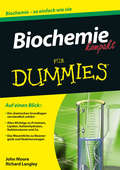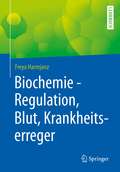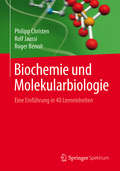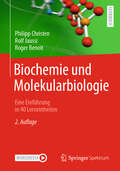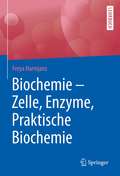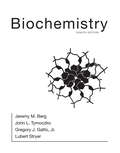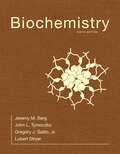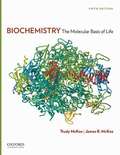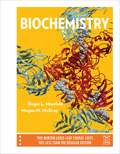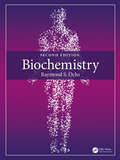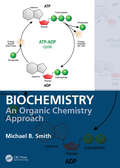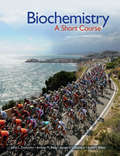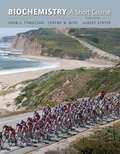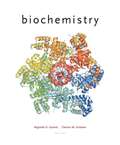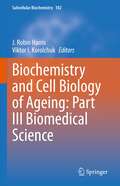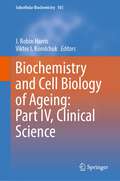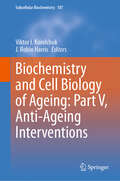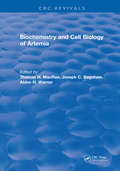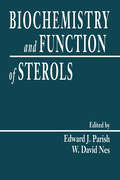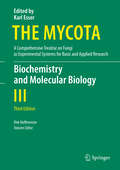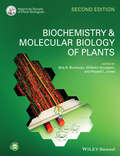- Table View
- List View
Biochemie für Dummies (Für Dummies)
by John T. Moore Richard H. LangleyHaben Sie Ihre liebe Mühe mit der Biochemie? Diese ganzen Formeln und Reaktionen sind überhaupt nicht Ihr Ding? Die nächste Prüfung steht vor der Tür? Kein Problem! In diesem Buch erklärt der Autor Ihnen, was Sie über Biochemie wissen müssen. Er führt Sie so einfach wie möglich und so komplex wie nötig in die Welt der Kohlenhydrate, Lipide, Proteine, Nukleinsäuren, Vitamine, Hormone und Co. ein. So leicht kann Biochemie sein.
Biochemie für Mediziner für Dummies (Für Dummies)
by Gerhard PüschelIhr Wegweiser durch den Dschungel der Biochemie Sie müssen eine Biochemie-Prüfung bestehen und Biochemie erscheint Ihnen so unanschaulich und schwer verständlich, das absolute Horrorfach? In diesem Buch werden biochemische Grundlagen und Zusammenhänge leicht verständlich erklärt. Über 300 speziell für dieses Buch entworfene Abbildungen und Schemata machen den Stoff anschaulicher und helfen Ihnen, den Durchblick zu bekommen. Gerhard Püschel erklärt Ihnen Stoffwechselwege und deren Regulation, Kommunikation zwischen Zellen und Organen, Zellzykluskontrolle und vieles mehr auf wissenschaftlich aktuellem Stand, aber »gut verdaulich«, damit das Lernen auch ein wenig Spaß macht. Sie erfahren Was Sie über Kohlenhydrat-, Lipid- und Proteinstoffwechsel wissen sollten Welche Funktion Vitamine und Spurenelemente haben Wie Replikation, Transkription, Translation und Kontrolle der Genexpression funktionieren Wie Hormone, Cytokine und deren Rezeptoren Zell- und Organfunktion steuern
Biochemie kompakt für Dummies (Für Dummies)
by Richard H. Langley John T. MooreStehen Sie auf Kriegsfuß mit der Biochemie? Diese ganzen Formeln und Reaktionen sind überhaupt nicht Ihr Ding? Die nächste Prüfung steht vor der Tür? Kein Problem! "Biochemie kompakt für Dummies" erklärt Ihnen das Wichtigste, was Sie über Biochemie wissen müssen. Sie werden so einfach wie möglich und so komplex wie nötig in die Welt der Kohlenhydrate, Lipide, Proteine, Nukleinsäuren, Vitamine, Hormone und Co. eingeführt. So leicht und kompakt kann Biochemie sein.
Biochemie kompakt für Dummies (Für Dummies)
by John T. Moore Richard H. LangleyDer schnelle Überblick für Schüler, Studenten und jeden, den es sonst noch interessiert Stehen Sie auf Kriegsfuß mit der Biochemie? Diese ganzen Formeln und Reaktionen sind überhaupt nicht Ihr Ding, aber die nächste Prüfung steht vor der Tür? Kein Problem! Biochemie kompakt für Dummies erklärt Ihnen das Wichtigste, was Sie über Biochemie wissen müssen. Sie warden so einfach wie möglich und so komplex wie nötig in die Welt der Kohlenhydrate, Lipide, Proteine, Nukleinsäuren, Vitamine, Hormone und Co. eingeführt. So leicht und kompakt kann Biochemie sein.
Biochemie - Regulation, Blut, Krankheitserreger
by Freya HarmjanzWenn Sie die Biochemie im Großen und Ganzen verstehen wollen, ohne Unmengen von Details auswendig zu lernen, sind Sie hier richtig. In diesem Buch beginnt jedes Kapitel mit einer verständlichen Abbildung für den Überblick, bevor es in die Tiefe geht. So laufen Sie nicht Gefahr, den Überblick zu verlieren.Bei der Erklärung der vielen Moleküle werden die Zusammenhänge innerhalb der Biochemie dargestellt und dabei die drei wichtigen Fragen beantwortet:· Woher kommt das Molekül?· Was macht es hier?· Wo geht es danach hin?Und für die Klinik gibt es Antwort auf die spannende Frage:· Was passiert eigentlich, wenn hier was schief geht?Da die Semesterklausuren häufig schwieriger sind als das Examen, legt das Buch seinen Schwerpunkt auf die Klausuren. So sind Sie für alle Fälle gut gerüstet. Und damit die Biochemie handlich bleibt, ist der Stoff auf drei Bücher verteilt:Zelle, Enzyme und praktische BiochemieEnergiestoffwechselRegulation, Blut, Krankheitserreger
Biochemie und Molekularbiologie: Eine Einführung in 40 Lerneinheiten
by Philipp Christen Rolf Jaussi Roger BenoitDiese Einf#65533;hrung in die Biochemie und Molekularbiologie ist f#65533;r alle geschrieben, die sich f#65533;r die molekularen Aspekte der Lebensvorg#65533;nge interessieren, insbesondere f#65533;r Studierende der Medizin und der Naturwissenschaften, denen die Biochemie als Grundlagenwissenschaft dient. Die 40 kurzen Kapitel k#65533;nnen weitgehend unabh#65533;ngig voneinander benutzt werden. Mit seinem hohen Bildanteil setzt das Buch auf visuelles Lernen. Zu jedem Kapitel gibt es eine ausf#65533;hrliche, kommentierte Linksammlung, die u. a. Bildmaterial, Animationen, Datenbanken sowie Merks#65533;tze und Kontrollfragen enth#65533;lt. Die Inhalte der Website k#65533;nnen #65533;ber QR-Codes im Buch, aber auch #65533;ber die Webadresse abgerufen werden. Das Lehrbuch basiert auf dem 2005 von den Autoren ver#65533;ffentlichten Titel Biochemie. Der Text ist korrigiert, erg#65533;nzt und gestrafft worden.
Biochemie und Molekularbiologie: Eine Einführung in 40 Lerneinheiten
by Philipp Christen Rolf Jaussi Roger BenoitDiese Einführung in die Biochemie und Molekularbiologie ist für alle geschrieben, die sich für die molekularen Aspekte der Lebensvorgänge interessieren, insbesondere für Studierende der Medizin und der Naturwissenschaften, denen die Biochemie als Grundlagenwissenschaft dient. Die 40 kurzen Kapitel können weitgehend unabhängig voneinander benutzt werden. Mit seinem hohen Bildanteil setzt das Buch auf visuelles Lernen. Über eine das Buch ergänzende Website erhalten Sie Zugang zur ausführlichen, kommentierten Linksammlung, die u.a. Bildmaterial, Animationen, Datenbanken sowie Merksätze und Kontrollfragen für jedes einzelne Kapitel enthält. Für die Neuauflage haben die Autoren den Text überarbeitet und aktualisiert; im Methodenteil ist die Beschreibung der bildgebenden Verfahren ausgebaut worden.
Biochemie - Zelle, Enzyme, Praktische Biochemie
by Freya HarmjanzWenn Sie die Biochemie im Großen und Ganzen verstehen wollen, ohne Unmengen von Details auswendig zu lernen, sind Sie hier richtig. In diesem Buch beginnt jedes Kapitel mit einer verständlichen Abbildung für den Überblick, bevor es in die Tiefe geht. So laufen Sie nicht Gefahr, den Überblick zu verlieren. Bei der Erklärung der vielen Moleküle werden die Zusammenhänge innerhalt der Biochemie dargestellt und dabei die drei wichtigen Fragen beantwortet: · Woher kommt das Molekül?· Was macht es hier?· Wo geht es danach hin? Und für die Klinik gibt es Antwort auf die spannende Frage: · Was passiert eigentlich, wenn hier was schief geht? Da die Semesterklausuren häufig schwieriger sind als das Examen, legt das Buch seinen Schwerpunkt auf die Klausuren. So sind Sie für alle Fälle gut gerüstet. Und damit die Biochemie handlich bleibt, ist der Stoff auf drei Bände verteilt: Band 1 Zelle, Enzyme und praktische Biochemie Band 2 Energiestoffwechsel Band 3 Regulation, Blut, Krankheitserreger
Biochemistry
by Jeremy M. Berg John L. Tymoczko Gregory J. Gatto Jr. Lubert StryerFor four decades, this extraordinary textbook played an pivotal role in the way biochemistry is taught, offering exceptionally clear writing, innovative graphics, coverage of the latest research techniques and advances, and a signature emphasis on physiological and medical relevance. Those defining features are at the heart of this edition. See what's in the LaunchPad
Biochemistry: A Short Course (loose-leaf) (Lange Case Files Ser.)
by Jr. John L. Tymoczko Jeremy M. Berg Lubert Stryer Gregory J. GattoBiochemistry
Biochemistry: The Molecular Basis of Life
by James R. Mckee Trudy MckeeBiochemistry: The Molecular Basis of Life is an intermediate, one-semester text written for students on degree pathways in Chemistry, Biology and other Health and Life Sciences. Aimed at students with one unit of Organic Chemistry, it focuses on essential biochemical principles that underpin the modern life sciences, and offers a balanced coverage of chemistry and biology.
Biochemistry
by Roger L. Miesfeld Megan M. McEvoyBiochemistry promotes understanding of biochemical concepts through highly readable chapters that consistently integrate stunning graphics with text. Its distinctive table of contents highlights how biochemical processes work, and applications to everyday biochemistry ensure that students develop a complete understanding of why biochemistry matters.
Biochemistry
by Raymond S. OchsBiochemistry Second Edition, is a single-semester text designed for undergraduate non-biochemistry majors. Accessible, engaging, and informative, it is the perfect introduction to the subject for students who may approach chemistry with apprehension. Its unique emphasis on metabolism and its kinetic underpinnings gives the text up-to-the-minute relevance for students investigating current public health concerns, such as obesity and diabetes. Biochemistry Second Edition will encourage students to explore the basics of chemistry and its influence on biological problems. Key Features: Provides an understanding of (mostly) enzymatic reactions that are responsible for the function and maintenance of living things. This innovative text for non-biochemistry majors includes introductory material at the beginning of each chapter that contextualizes chapter themes in real-life scenarios. Online supporting materials with further opportunities for research and investigation. Synthesis questions at the end of each chapter that encourage students to make connections between concepts and ideas, as well as develop critical-thinking skills. About the Author: Raymond S. Ochs is a biochemist with a career-long specialty in metabolism spanning 30 years. Previously, he has written the textbook Biochemistry, contributed the metabolism chapters to another text, Principles of Biochemistry, and co-edited a collection of articles published as Metabolic Regulation, and the recent monograph Metabolic Strucure and Regulation. His research interests concern major pathways of liver and muscle, including glycolysis, gluconeogenesis, ureogenesis, fatty acid metabolism, glycogen metabolism, and control by cAMP, Ca2+, diacylglycerol, and AMPK. He is currently professor of pharmacy at St. John’s University in New York, teaching biochemistry, physiology, and medicinal chemistry.
Biochemistry: An Organic Chemistry Approach
by Michael B. Smith&“There is a continuing demand for up to date organic & bio-organic chemistry undergraduate textbooks. This well planned text builds upon a successful existing work and adds content relevant to biomolecules and biological activity&”. -Professor Philip Page, Emeritus Professor, School of Chemistry University of East Anglia, UK &“Introduces the key concepts of organic chemistry in a succinct and clear way&”. -Andre Cobb, KCL, UK Reactions in biochemistry can be explained by an understanding of fundamental organic chemistry principles and reactions. This paradigm is extended to biochemical principles and to myriad biomolecules. Biochemistry: An Organic Chemistry Approach provides a framework for understanding various topics of biochemistry, including the chemical behavior of biomolecules, enzyme activity, and more. It goes beyond mere memorization. Using several techniques to develop a relational understanding, including homework, this text helps students fully grasp and better correlate the essential organic chemistry concepts with those concepts at the root of biochemistry. The goal is to better understand the fundamental principles of biochemistry. Features: Presents a review chapter of fundamental organic chemistry principles and reactions. Presents and explains the fundamental principles of biochemistry using principles and common reactions of organic chemistry. Discusses enzymes, proteins, fatty acids, lipids, vitamins, hormones, nucleic acids and other biomolecules by comparing and contrasting them with the organic chemistry reactions that constitute the foundation of these classes of biomolecules. Discusses the organic synthesis and reactions of amino acids, carbohydrates, nucleic acids and other biomolecules.
Biochemistry: A Short Course (loose-leaf)
by Lubert Stryer John Tymoczko Jeremy Berg Gergory GattoDerived from the classic text originated by Lubert Stryer and continued by John Tymoczko and Jeremy Berg, Biochemistry: A Short Course focuses on the major topics taught in a one-semester biochemistry course. With its brief chapters and relevant examples, this thoroughly updated new edition helps students see the connections between the biochemistry they are studying and their own lives. The focus of the 4th edition has been around: * Integrated Text and Media with the NEW SaplingPlus Paired for the first time with SaplingPlus, the most innovative digital solution for biochemistry students. Media-rich resources have been developed to support students' ability to visualize and understand individual and complex biochemistry concepts. Built-in assessments and interactive tools help students keep on track with reading and become proficient problem solvers with the help and guidance of hints and targeted feedback--ensuring every problem counts as a true learning experience. * Tools and Resources for Active Learning A number of new features are designed to help instructors create a more active environment in the classroom. Tools and resources are provided within the text, SaplingPlus and instructor resources. * Extensive Problem-Solving Tools A variety of end of chapter problems promote understanding of single concept and multi-concept problems. Built-in assessments help students keep on track with reading and become proficient problem solvers with the help and guidance of hints and targeted feedback--ensuring every problem counts as a true learning experience. Unique case studies and new Think/Pair/Share Problems help provide application and relevance, as well as a vehicle for active learning.
Biochemistry: A Short Course (Second Edition)
by John L. Tymoczko Jeremy M. Berg Lubert StryerThis book covers the fundamentals of biochemistry and its topics are broadly grouped under three parts : Molecular design of life,Transducing and storing energy and Synthesizing the molecules of life.
Biochemistry (6th Edition)
by Reginald H. Garrett Charles M. GrishamContinuing Garrett and Grisham's innovative conceptual and organizing Essential Questions framework, BIOCHEMISTRY guides students through course concepts in a way that reveals the beauty and usefulness of biochemistry in the everyday world. Offering a balanced and streamlined presentation, this edition has been updated throughout with new material and revised presentations. For the first time, this book is integrated with OWL, a powerful online learning system for chemistry with book-specific end-of-chapter material that engages students and improves learning outcomes.
Biochemistry and Cell Biology of Ageing: Part III Biomedical Science (Subcellular Biochemistry #102)
by J. Robin Harris Viktor I. KorolchukThis book provides a state-of-the-art overview of key areas of subcellular aging research in human cells. The reader is introduced to the historical development and progress in biomedical aging research and learns, for example, about the role of microRNAs, circRNAs, mitochondria and extracellular vesicles in cellular senescence. The reader will also learn more about how gap junctions, the nuclear pore complex and the proteasome are affecting the ageing processes. In addition, novel therapeutic opportunities through modulation of cellular senescence are discussed. The book follows on from Parts I and II of Biochemistry and Cell Biology of Ageing (Volumes 90 and 91 of the Subcellular Biochemistry book series) by covering interesting and significant biomedical ageing topics not included in the earlier volumes. Comprehensive and cutting-edge, this book is a valuable resource for experienced researchers and early career scientist alike, who are interested in learning more about the fascinating and challenging question of why and how our cells age.
Biochemistry and Cell Biology of Ageing: Part IV, Clinical Science (Subcellular Biochemistry #103)
by J. Robin Harris Viktor I. KorolchukThis book provides an up-to-date overview of key areas of ageing research and bridges the gap between the subcellular events and the reality of ageing as seen in clinical practice.To this end, the reader learns about the historical development and progression of clinical ageing research. All chapters address the biochemistry or cell biology of various ageing events (to the extent that the data are available) and work their way to the clinical understanding we have of ageing. The focus of this volume is on how dietary restriction, virus infection and chronic inflammation affect the ageing process. Additionally, this book discusses how phosphate metabolism and metabolic dysfunction contribute to ageing events and how various organs and tissues (e.g. tendons, ears, heart muscle, and the endocrine system) age. This book follows on from Parts I, II and III of Biochemistry and Cell Biology of Ageing within the Subcellular Biochemistry book series and aims to bring the subcellular and clinical areas into closer contact by including interesting and significant biomedical ageing topics that were not included in the earlier volumes. Comprehensive and cutting-edge, this book is a valuable resource for experienced researchers and early career scientist alike, who are interested in learning more about the fascinating and challenging question of why and how our cells age.
Biochemistry and Cell Biology of Ageing: Part V, Anti-Ageing Interventions (Subcellular Biochemistry #107)
by Viktor I. Korolchuk J. Robin HarrisThis book provides an up-to-date overview of key areas of ageing research with a special focus on anti-ageing intervention strategies, which are currently very much at the forefront of ageing studies.The volume discusses how dietary restriction, supplements or exercise affect the ageing process. Other intervention strategies reviewed are: chaperone activators, telomerase activation, hormetics, senolytics, NAD boosting, geroprotectors, stem cell therapies, resveratrol and melatonin, to just name a few. This book follows on from Parts I-IV of Biochemistry and Cell Biology of Ageing within the Subcellular Biochemistry book series and highlights anti-ageing intervention strategies that were not included in the earlier volumes. Comprehensive and cutting-edge, this book is a valuable resource for experienced researchers and early career scientists alike, who are interested in learning more about the fascinating and challenging question of why and how our cells age.
Biochemistry and Cell Biology of Artemia
by Thomas H. MacRaeThe unusual life history of the brine shrimp, Artemia, and the relative ease with which it can be experimentally manipulated have long made his crustacean a favorite system for biological studies. Over the years, descriptive morphological work has given way to a rigorous analysis of biochemical and cellular aspects of the organism. The underlying theme of the work is often been developmental in nature.This book brings together a wide spectrum of topics under study in the shrimp. Analyses of gene structure and protein synthesis are combined with descriptions of protein interactions characteristic of functional cells.
Biochemistry and Function of Sterols
by Edward J. Parish W. David NesLeading international scientists bring current and developing topics in sterol research together in Biochemistry and Function of Sterols. The authors are experts in each major area of sterol research-medicine, biochemistry, chemistry, and agriculture. Each chapter features the current state of research as well as new and developing research topics. Throughout the volume the focus is on the major and expanding areas of sterol biochemistry and function of sterols in all classes or organisms. The broad scope of this work embraces many disciplines and will be of interest to a variety of researchers, students, and lay people. Professors will find Biochemistry and Function of Sterols an excellent choice as a textbook for courses on steroid, lipid, or plant biochemistry.
Biochemistry and Molecular Biology (The Mycota #III)
by Dirk HoffmeisterThis new edition provides a comprehensive look at themolecular genetics and biochemical basis of fungal biology, covering importantmodel organisms such as Aspergilli while also integrating advances made with zygomycetes and basidiomycetes. This book groups a total of 15 chapters authored by expert scholars in theirrespective fields into four sections. Five chapters cover various aspects ofgene expression regulation. These range from regulation in organismalinteractions between parasitic fungi and their host plant, heavy metal stressand global control of natural product genes to conidiation and regulationthrough RNA interference. Two chapters are dedicated to signal transduction,highlighting MAP-kinase-dependent signaling and heterotrimeric G-proteins. Fungal carbohydrates are the subject of the third section, which addresses bothpolymeric cell wall carbohydrates and trehalose as an important, low molecularweight carbohydrate. The fourth section emphasizes the metabolism of majorelements (carbon, nitrogen, sulfur) and critical cellular pathways for primaryand secondary products.
Biochemistry and Molecular Biology Compendium
by Roger L. LundbladThis book is an accessible resource offering practical information not found in more database-oriented resources. The first chapter lists acronyms with definitions, and a glossary of terms and subjects used in biochemistry, molecular biology, biotechnology, proteomics, genomics, and systems biology. There follows chapters on chemicals employed in biochemistry and molecular biology, complete with properties and structure drawings. Researchers will find this book to be a valuable tool that will save them time, as well as provide essential links to the roots of their science. Key selling features: Contains an extensive list of commonly used acronyms with definitions Offers a highly readable glossary for systems and techniques Provides comprehensive information for the validation of biotechnology assays and manufacturing processes Includes a list of Log P values, water solubility, and molecular weight for selected chemicals Gives a detailed listing of protease inhibitors and cocktails, as well as a list of buffers
Biochemistry and Molecular Biology of Plants
by Russell L. Jones Bob B. Buchanan Wilhelm Gruissem"Biochemistry & Molecular Biology of Plants" is a major contribution to the plant sciences literature, superbly edited by three distinguished scientists, Bob B. Buchanan, Wilhelm Gruissem, and Russell L. Jones, with contributions from more than 50 world-renowned scientists. With over 1,400 pages, 1,100 full-colour original drawings and 500 photographs this work qualifies, in the words of the Science reviewer, as: ""an essential reference for practicing plant biologists and for the increasing number of scientists from other disciplines who are entering the field of plant biology. To exploit fully the wealth of new information provided by the genome projects and to integrate the metabolic, regulatory, and signal transduction pathways of complex organisms, biologists will require a solid command of biochemistry and physiology. For this reason, the publication of Biochemistry Molecular Biology of Plants could not have come at a more opportune and auspicious time. " " This book is meticulously organised and richly illustrated, useful both for teaching and for reference. The multi-authored work provides a contemporary view of its subject, including molecular biology, cell biology, and plant physiology, integrated around the themes of: * compartmentation * cell reproduction * energetics * metabolism * development Read the words of the reviewer in CELL: ""The great strength of this book is that it has integrated its three major components (molecular biology, cell biology, and plant biochemistry) in each of the 24 chapters, resulting in a comprehensive analysis of a multitude of specific topics. " " Who should buy this spectacular text? * Plant biologists and scientists in related fields * Professors in departments of plant biology, plant biochemistry, plant physiology, and related fields * Graduate and upper-level undergraduate students of plant biology * Researchers in the pharmaceutical, biotechnology, and agribusiness industries Images are available directly from the ASPB web site at http: //www. aspb. org/publications/biotext/
